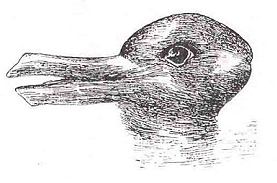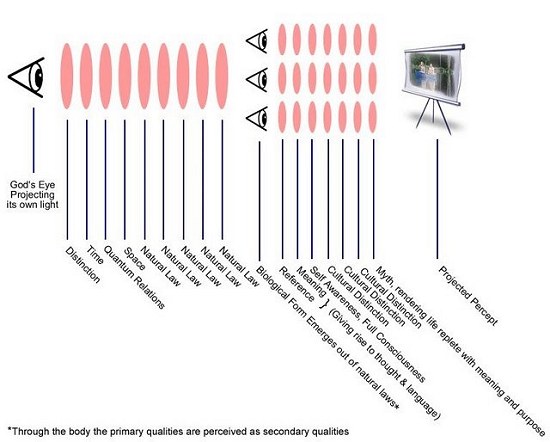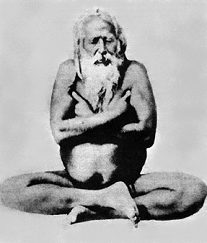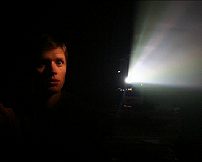 |
 |
 |
| Home | Essays |
Wikipedia | Resources | Portals & Archives |
|
Sanskaras |
|
||||||||||||
"Sanskaras are impressions of duality which make the soul go through the process of duality to attain unity with God. The soul cannot attain unity consciously unless it goes through conscious experiences of duality, and these experiences of duality cannot be had but by impressions of duality. |
Meher Baba and Sanskaras An explanation of Sanskaras based on a study of the teachings of Meher Baba by Christopher Ott |
||||||
|
What are sanskaras?
Meher Baba elucidated a lot on a dharmic (Hindu, Buddhist, Sikh, Jain) concept known as the "sanskara". In 1937, shortly before beginning dictating his discourses, Baba said, "I will give you some very new facts concerning sanskaras; truly, no philosophical books explain the term properly." (LM 2250) In fact, Meher Baba elucidated on this subtle concept more than anyone before or since. The concept of the "sanskara", along with "impression", its English translation, are mentioned more than 500 times in Baba's major book God Speaks and whole chapters are dedicated to elucidating on it in his Discourses. So, it seems that for anyone interested in understanding Meher Baba's metaphysics, it is worth the trouble to know exactly what sanskaras are. Simply put, sanskaras are the imprints left on the subconscious mind by experience, which then condition and color all of a person's life - from the main goals one has set for his life to one's transitory point of view at a given moment, from one's most highly held beliefs and values to one's minutest behavioral traits. And since Meher Baba places reincarnation as part of a soul's journey from its primordial unconsciousness to its final self-realization, it follows that sanskaras gathered by experiences in one incarnation get passed to the next incarnation. Getting an intuition of the concept Before focusing on the definition of the term, it is useful to develop an intuition of what sanskaras are by connecting them with issues most of us are familiar with and through examples that may help us discern their continuous influence in our daily experience of life. Although a psychoanalyst or a psychotherapist are not very likely to know the term sanskara, they are dealing with it continuously in their careers. Trying to help a patient recall a buried traumatic memory in order to find the source of a phobia or trying to help a patient leave behind a pattern of self-defeating behavior are most certainly processes that deal with specific sanskaras or clusters of sanskaras. And indeed a very clear example of a sanskara at work is in repressed traumatic memories. Such memories may come from instances of abuse, accidents or natural disasters during childhood, as well as from more long-term exposure to very negative situations, like having an alcoholic parent or growing up in wartime. In such cases, when an object or event similar to the one held in the buried memory is encountered, there is a psychological reaction, like feelings of anxiety, fear or depression. So a person may have a spontaneous fearful reaction towards, say, a bearded old man, or a dog or may get depressive near a drunk person. We can also think of examples involving positive reactions. If we went on a vacation where there are palm trees, and we have been left with a fond impression of that experience, whenever we see palm trees in the future we might be calmed or cheered up. It is as if the past experience creates a lens that colors how we see similar or related objects in the future. Sanskaras or links between sanskaras can also be created artificially. If a person keeps seeing an advertisement of very happy people consuming some drink under palm trees, he may also start feeling cheered at the sight of palm trees, or of the advertised drink. What is interesting about impressions left on us by past experience is that they do not need to be remembered directly. In fact, they retain even more strength when they are not remembered, because they do not come to the surface of awareness to be worked out. To see this we need only consider how much more impressed humans are by traumas and happy experiences in their infancy, than later in their lives. It is as if the more forgotten the incident that left the impression the stronger it impresses itself upon the psyche. Considering reincarnation, experiences that happened in a previous lifetime, that are entirely forgotten and lie dormant only in the subconscious memory, continue to drag their effects into our current life. According to Meher Baba, it is entirely for the purpose of bringing these impressions to the surface of awareness (not the memory, but the impression) in order to work them out through further actions, that we take a new birth. We respond to these past impressions entirely unaware of them; it is an automatic reaction in the psyche and requires no effort. The Duck-rabbit example A fun way to explain the effect of the storehouse of forgotten memories on how we see things, is the famous "Duck-rabbit" illusion.  Look at this image. Most people, if they try, can see it either as a duck or as a rabbit. Look at this image. Most people, if they try, can see it either as a duck or as a rabbit.What looks like long ears sweeping backward on a bunny if pictured facing right can be seen as the beak of a duck when pictured as an animal facing to the left. Note that you can't see both at the same time. You can alternate from seeing it as a duck and then a rabbit, but never both at the same time. This effect is known in psychology as apperception - seeing something in the present through the lens of something experienced in the past. Now, to see this as a duck you need to have a storehouse of experiences seeing ducks. The same for seeing it as a rabbit. But imagine you had come from a place where ducks did not exist and you had never seen anything remotely like such a creature. Then you could not see the duck. How you see and interpret an image relies on your past experience. Now compare this to what is written in Meher Baba's Discourses:
In the real world you would act one way if you saw a duck and another way if you saw a rabbit. Thus how one sees, through one's past impressions, has direct causative effect on how you act and respond.
Incidentally, the word psychogenesis means - originating in the mind or in mental or emotional processes; having a psychological rather than a physiological origin. Using the analogy of eye-glasses  Baba uses various analogies to explain sanskaras. In The Discourses he gives the analogy of a stain left behind on some garment. Even after many washings, the stain or impression of the past incident (such as a spill) remains in the cloth, even if only very faint. He also gives the analogy of a ball of string that is being wound around a stick, the string representing sanskaras and the stick the mind of the individual. To stop the further winding of the string would be to cease creating fresh sanskaras. To start unwinding the string would be to mentally reverse the process which lead to their formation. But to cut the string completely would be to annihilate all sanskaras, which can only be done by a perfect master to free the person from his impressions so he can be ultimately free of his imagined projections and see his true Self. Baba uses various analogies to explain sanskaras. In The Discourses he gives the analogy of a stain left behind on some garment. Even after many washings, the stain or impression of the past incident (such as a spill) remains in the cloth, even if only very faint. He also gives the analogy of a ball of string that is being wound around a stick, the string representing sanskaras and the stick the mind of the individual. To stop the further winding of the string would be to cease creating fresh sanskaras. To start unwinding the string would be to mentally reverse the process which lead to their formation. But to cut the string completely would be to annihilate all sanskaras, which can only be done by a perfect master to free the person from his impressions so he can be ultimately free of his imagined projections and see his true Self.One very helpful explanation of the function of sanskaras is Baba's analogy of them as tinted glasses you look through which affect how you see things. If you look through a set of red tinted glasses you see the world as shaded red; if you look through a set of blue tinted glasses the world is seen as having a blue cast. What has changed is not the world, but the lens through which you experience it - the conditioning of the mind. One person, seeing through mind that is conditioned by a particular set of sanskaras, sees the world one way, while another person whose mind is conditioned by a different set of sanskaras sees the world in a different way, consistent with those impressions. All of these ways of seeing reality are in imagination and therefore false. Only the unconditioned mind cleared of all sanskaras sees reality as it really is. From this analogy we can also see the relation between sanskaras and karma (physical and mental actions). Consider the sense in which how you see things predetermines how you respond to them. If tigers raised you and you saw a tiger you might react in a very different way from a person who's parents were eaten by tigers. And so forth. How you see is really where the sanskara most precisely has its life. The action (karma) is merely the consequence. We can also see how sanskaras affects judgments. If you look at an object or witness an occurrence you can say quite a bit about it. You can say if it is good or bad, just or unjust, attractive or repulsive, and to which degree such a quality applies. But from Baba's point of view all such judgments are due to how you are looking at it, the impressional lenses (sanskaras) you are looking at it through. Meher Baba reminds us repeatedly that the witness, the seeing, is really always one and the same, and remains in and with and one with Paramatma (God).
Approaching a first definition A general sense of what Baba means by sanskaras should have become clear at this point: A sanskara is the faint impression left behind by past experience. Sanskaras result in ways of seeing determined by mostly forgotten memories in this or in a previous life. They also cause us to act like we do when we have new experiences that relate to certain forgotten memories. We can't see our sanskaras. Just like we can't see our glasses when we wear them. But glasses are things, whereas sanskaras are not. They are what cause the appearance and evaluation of things. And they make us do what we do. They are our psychology. But even though we can't see sanskaras, we can discover them by examining our habits and actions, our likes and dislikes. We know them by their effect. Whenever we make a choice, or have a strong response, we can be assured that it is due to some sanskara we have that we were not aware of. In general people think they are acting freely when they do what they want. What they don't know is that everything they want is dictated by their sanskaras, which they cannot see or control. Thus he who follows his desires is simply following the dictates of his sanskaras. After this first approach to a definition let us move to another aspect of sanskaras. The original sanskara As already explained, past experiences cause sanskaras and sanskaras subsequently cause desires. Desires then lead to actions and these actions bring about (and are in themselves) new experiences, which create further sanskaras. Looking back in time, it is normal to wonder how all this started in the first place. What was the very first desire that caused the very first sanskara to be? Because of necessity, "in the beginning", the first desire which preceded Creation itself was NOT caused by a sanskara. And Meher Baba said that this desire was an urge-to-know, the Original Whim, which has by definition no cause. In philosophical parlance it can be called the "first cause", the cause that caused all subsequent causes. However, that early in the story, what was there to know for this "first urge-to-know"? The only reality there was to know was God Himself. And without a subject-object duality, how can God get from His original Unconscious State to His Conscious State? So at that early point God simply desired to know, to know anything that would lead towards answering the question "Who am I?". Now remember that desires cause actions. So this first desire (which had no prior cause) caused the first action which was a mental action, the surge of the question "Who am I?", the "Logos" in biblical terms. And this set up a domino effect, a chain of events (in God's imagination) that led to all this Creation that we find "ourselves" illusorily in. But the mechanism after the first urge remained one and the same. It was the mechanism of desires leading to actions which cause experiences, which cause new sanskaras, which cause new and more elaborate desires, leading to more actions which in turn create new experiences, which leave further sanskaras, and so forth ad infinitum. Sanskaras of the universal mind and individualization The first desire which caused the first experience occurred in Original Beyond State of God, in the formless Infinite Intelligence. In turn and in the course of this domino effect of responding to sanskaras and in turn building new sanskaras, things got more and more complicated (even as the mechanism remained simple). At some point in this process, the appearance of separation gradually occured and the sense of separate individuality arised out of it all. In truth nothing ever separated from anything, except in appearance. And in fact there really is only one soul, that being God. But this sense of separate identity gives to the soul an impression of separation that is so vivid that we call this an "individual soul" (atma). But in truth, there is no way for God to divide himself except in his own vivid imagination. Thus it is said that atma always was, is, and remains one and identical with Paramatma (the Over-soul). A most eloquent description of this notion is found in the words of Ralph Waldo Emerson from his essay "The Over-Soul" published in 1841.
How God's sanskaras build first His experience and then ours. A sanskara is most basically a way of seeing. Actions (karma) are simply the consequence of sanskaras. I will say this again; a sanskara is most basically a way of seeing. Most exactly, even to say that a sanskara is a way of seeing "something" is not quite right. The sanskaras, taken together, are actually what produce the thing seen. How can this be? There are two analogies that Baba uses that help us understand this process by which we create what we see in the act of seeing it. I want to touch on these briefly and then expand on them later. The first is with an analogy of light -- light representing spirit. Light analogy  Imagine a lit light bulb in an inky-black empty universe. It casts its light in all directions and it disperses in all directions, hitting upon nothing as there is nothing in this universe save this light bulb. Now imagine being this light bulb. Turning around in all directions, what would you see? Nothing. For there is nothing in the Universe for your light, which emanates from you, to reflect back to you on.  Next, imagine a movie theater. Imagine further there is a light bulb shining in the projector in the projection booth. It casts its light in all directions in the booth and the light disperses or is absorbed by the black housing of the projector. But now put a lens in front of that light and what happens? Light now shines out in the direction of the lens focused on the screen in the movie theater. Imagine you are this light bulb again. What do you see in the direction of the movie theater screen? You see white light. Next, imagine a movie theater. Imagine further there is a light bulb shining in the projector in the projection booth. It casts its light in all directions in the booth and the light disperses or is absorbed by the black housing of the projector. But now put a lens in front of that light and what happens? Light now shines out in the direction of the lens focused on the screen in the movie theater. Imagine you are this light bulb again. What do you see in the direction of the movie theater screen? You see white light.Now place a colored strip of film, a piece of colored celluloid in front of the bulb. What now appears on the movie theater screen? Colors dancing about in all shapes and forms. In this analogy the light is God. The lens is the mind, the filmstrip the sanskaras, and the show on the screen the Creation. Consider this analogy given by Meher Baba of the cinema operator.
This analogy of light is very ancient. It can be found in Plato's analogy of the cave, in Neoplatonism, Emanationism, and in Sufi philosophies such as Illuminationism. Baba has merely modernized it with the addition of the movie projector analogue. Seeing analogy We first talked of spirit using the analogy of light as it forms an image on a screen. Now we will talk about spirit more as it truly is, as seeing. Imagine again the same inky empty sea of space as before. But this time imagine in this inky empty sea of space an eye. It is all that is. What does this eye see if it stares into the inky blackness? Nothing of course. It cannot even recognize its own existence, for there is nothing to see and thereby say "I am not that; I must be its witness." This eye, let us imagine, now imagines ways of seeing (sanskaras - lenses) that it looks through. But what is it really looking at? Nothing, for there is nothing but itself. Thus truly this Divine seeing sees only its own seeing - itself. But it sees itself falsely through imagined lenses. This trouble in imagining seeing seeing seeing is why the analogy of light is given by all mystics. If we combine these analogies we can compare this spirit of seeing to a self-luminous seeing, that sees its own light (first falsely through impressions, then truly without impressions). The seeing is the light that it sees. The light that it sees is seeing. The new intuition is reliant on combining two analogues as one. But mystics generally give them separately.  Now this seeing is all one and unified, but its seeing through numerous imagined impressions (sanskaras) that it gives to itself in ignorance gives rise to itself the impression of separateness.
Creating a model Now to grasp how nothing but this seeing (God) and ways of seeing (imagination - sanskaras) give rise to all that we look about and see, all that we could find if we went looking but do not ourselves see, to the entire universe, we must have a very simple model. While this model is not given by Meher Baba, it is not inconsistent with what he has taught. Rather than looking at it as a separate theory, merely look at it as a conceptual tool for getting some intuition of what Baba and all mysticisms are trying to tell us. When God had the impulse of the original whim, he wanted to know himself. There was nothing but himself to know but he did not in the beginning know this. And so he strained to see what he might be. And in this very act of attempting to see 'something' 'anything' that might be there to be, in the very instance of thinking in ignorance he was somehow 'out there' this in itself formed a division. For in the very moment of straining to experience, there was the 'moment' before he did so. And this caused the first sanskara (or impression left by action) that we know as time. And also, in that same instant, in his staring out from himself into his imagination as if anything in that imagination was 'out there' beyond himself, he formed the sanskara (way of seeing) of space. It was then in terms of time and space that God could make divisions, and by divisions he might multiply divisions by divisions, separate imagined separateness, and these experiments that God performed in his infinite intelligence thinking falsely through imagined time and space we now call natural laws. And among these natural laws are the laws by which things form. And out of these laws of formation emerged these bodies. And through these bodies there emerged in imagination color, sound, smell, and taste as we know them. And staring into these imagined qualities, through bodies born of natural laws, born out of space, born out of time, born out of God's desire to see and know himself due to his whim to know, God found himself against the backdrop of his imagined world as a fully self-aware conscious human being - one apparently amongst many. And all that he saw around himself were really nothing but the relics of his own imagined evolution. 
Getting rid of sanskaras Baba tells us that sanskaras serve a vital purpose. It is through the formation of sanskaras that we form in imagination the world and find ourselves in the world. It is against the backdrop of this illusory world, this 'other', that we demarcate ourselves and say at last as human beings, "I am" "I must be." But this is not the end of the game (called the lila in Vedanta - which translates as 'divine sport'), for we find ourselves in the world with a bad case of mistaken self-identity.  While it is ironically through ignorance that the sense of "I am" (conscious self-awareness) comes about, the real identity of God (the witness and creator of all this illusion he now finds himself in) remains a mystery to him as long as his mind remains conditioned by sanskaras. For while he has found "a" self to take himself as, he has mistakenly picked it from the content of his imagination -- the male or female body that he takes himself to be. He sees, and knows that he sees, but he unfortunately sees falsely through millions of impressions (sanskaras) gathered over the course of arriving at this fine condition. So what to do? How can he, who has at last found himself but found himself falsely, see himself truly as he really is, as the original light of seeing? It is very difficult. While it is ironically through ignorance that the sense of "I am" (conscious self-awareness) comes about, the real identity of God (the witness and creator of all this illusion he now finds himself in) remains a mystery to him as long as his mind remains conditioned by sanskaras. For while he has found "a" self to take himself as, he has mistakenly picked it from the content of his imagination -- the male or female body that he takes himself to be. He sees, and knows that he sees, but he unfortunately sees falsely through millions of impressions (sanskaras) gathered over the course of arriving at this fine condition. So what to do? How can he, who has at last found himself but found himself falsely, see himself truly as he really is, as the original light of seeing? It is very difficult.Not least among the obstacles to his seeing as things are is that all efforts that he makes to rid himself of sanskaras, by working them out through action, create new sanskaras. Thus just at the point that he is about to have worked out the last sanskaras that he brought with him from his last life, the sanskaras gathered in the act of working those sanskaras off have caused him to gather a whole new batch. And thus upon death these newly gathered sanskaras form the matrix for his next body and birth, and force him to work in the opposite direction from the previous birth. This puts God as a man (now fully conscious, seeing but seeing falsely) in a vicious cycle of births and deaths and what Baba calls a virtual stalemate. Even if man, coming to know of these things, attempts to take no action, and thereby create no new sanskaras, he takes the sanskaras of inaction and sloth. So there is no way out, except through the slow and arduous process of wearing gross sanskaras into subtler ones and these into finer ones, and to 'regress' slowly backward through the process that Baba calls 'involution.' But this process can take millions of lives. Baba says that, without help from a master who has attained experience of reality by having no sanskaras at all, the human being has to endure 8,400,000 human incarnations even before taking the first step on the spiritual path known as involution. Luckily all this can be sped up, Baba tells us, by finding a perfect master (sadguru or qutub) and winning his help. The impressioned mind is entirely incapable on its own efforts of wiping out its own impressions. Just as a person covered in oil has no chance of wiping away the oil with his oily hands. He needs the dry towel that is the perfect master. For the impressioned mind to overcome its ignorance requires the help of a greater (unimpressioned and thus perfect) mind. This is the perfect master. What sanskaras are not Sanskaras are, in a sense, the smallest building block of illusion, the smallest building block of consciousness, much as some of us were taught in school that atoms are the smallest building block of matter. But what has to be gotten across is that sanskaras are not 'analogous' to atoms, because they aren't things that take up space and fit on the head of a pin. They are entirely psychogenic. There is true spiritual discussion of sanskaras that can inadvertently mislead one to think of them as things. For instance there is the sense in which meat contains animal impressions, and this is why being vegetarian is sometimes good for an aspirant. This can lead someone to imagine (with an imagination conditioned from gross experience to think of everything as things) that sanskaras are tiny microscopic objects in meat. In truth, all that we see (on all the planes but the 7th) supervenes upon impressions (sanskaras) and so everything we experience like meat, supernovas, everything is fundamentally nothing but sanskaras at work. But sanskaras should not be thought of as things that go through walls like quarks. They needn't go through a wall. They do not exist in space. They are what produce the appearance of space. Another common misconception arises when people read Baba discussing 'gross' or 'material' sanskaras, versus 'subtle' or 'mental' ones. Gross sanskaras are the courser less-fine sanskaras that make you see things physically; they are not themselves physical. Likewise subtle sanskaras cause subtle experiences and mental sanskaras cause mental experiences. Subtle sanskaras are not subtle objects and mental sanskaras are not thoughts. They are what cause the experience of such illusions. Things caused by sanskaras Here are some tendencies to look for in your life that are caused by your individual sanskaras. This will give you some idea what sanskaras create. |
||||||
|
• Your favorite color. • Your fears and phobias. • Your desires and cravings. |
||||||
| Certain things that seem to keep happening to you over and over in different ways, such as the same kinds of conflicts in relationships, marrying a series of alcoholics or abusive people, addictions, being accident prone, attracting certain recurrent reactions from people that you can't seem to explain, having money come to you easily, inability to hold onto money, being unlucky, being lucky, losing things, being observant, being temperamental or calm, being level headed, being extroverted or introverted, inexplicable underlying anxiety or inexplicable exuberance for no apparent reason. | ||||||
|
• A sense of dread. • A sense of uncrushable optimism. • Cowardliness. • Spontaneous bravery. • Physical attraction (or aversion) to a certain type of person. • Genius. • Dullness of mind or apathy. • Physical health or illness. • Birth defects. • Accidents. • Neurosis. • Poor brain chemistry such as psychosis, schizophrenia, or mental retardation. • Fortune and misfortune. • Economic status you are born to or inherit. • Physical beauty or lack there of. • Obesity or petiteness. • Compulsion to smoke or drink. |
||||||
| Now as sanskaras begin to thin, there are some things to look for: | ||||||
|
• Decreased interest in material things, when compared to most people. • Increased interest in thoughtful inquiry and in improving of one's character. • Inexplicable compassion for even the most apparently insignificant of people. • Inexplicable compassion for animals, plants, and the meekest of creatures. • Inexplicable concern for the feelings of others, even so-called "sinners" and "criminals." • Inexplicable generosity, and desire to sacrifice without recognition or reward. • Inexplicable ability to do very little. • Decreased interest in how the world sees you (not to be confused with a desire for others to view you poorly, which is still an interest) • Decreased interest in proving one's femininity or masculinity. • Decreased interest in power over other people and creatures. • Loss of interest in the concept of ownership. • Loss of interest in attainments, beyond the attainment of reality. |
||||||
| Now as sanskaras begin to almost entirely disappear here are some things to look for: | ||||||
|
• Inexplicable feeling of love for every person and creature with not only a desire not to harm them, but a desire to live or die for the slightest improvement of their lot. • Inexplicable yearning to find something lost that one cannot name. • Frequent bouts of total self-forgetfulness due to thoughts of others. • Insatiable thirst for something divine that one cannot define, nor does one feel any need to discuss. • Relentless heartache. • Acceptance of everything as God's will, thus no complaining. • Loss of all desire to explain to others how one is feeling. |
||||||
| Nothing need be said of what to look for when all sanskaras are perished, for it is said that one will simply know. Of what the perfect masters have said of this state when describing it we can surmise: | ||||||
|
• Absolutely no thoughts. • Absolutely no experience of malice. • A blackness or an indescribable cold. • A sense of being alone, but not lonely. • No desires at all. • No fears at all. • A feeling or perception of the entire universe coming out of oneself and returning to oneself. • No sense of a self as demarcated from any other person or thing. • Total and immediate experience of everyone's experience. • Limitless compassion. • Infinite knowledge or ability to discern. • Sense of boundlessness. • Sense of infinite power, knowledge, and unbridled bliss. • Lack of desire to change anything for everything appears perfect. • Lack of desire to attain or lose anything due to a perfect sense of self-sufficiency. • Sense of power to breathe in the universe, but no desire to do so. |
||||||
|
This state is said to be demarcated from other yogic states because it is permanent without a break. From what is said, no one will know when you are in the final supreme state but you won't care. Jesus, Buddha, Mohammad, Zoroaster, Krishna, and Ram were in this state. And also Meher Baba and the five perfect masters. |
 A cinema operator who is cranking the projector with his own hand and is at the same time deeply absorbed in watching the images on the screen. He becomes so deeply absorbed, that he forgets that it is his own hand which is cranking the machine, and out of which is being projected all of this which he sees on the screen. He laughs and weeps according to the scenes presented on the screen. In the process he forgets the unreality and non existing state of the scenes on the screen. (Meher Baba, II)
A cinema operator who is cranking the projector with his own hand and is at the same time deeply absorbed in watching the images on the screen. He becomes so deeply absorbed, that he forgets that it is his own hand which is cranking the machine, and out of which is being projected all of this which he sees on the screen. He laughs and weeps according to the scenes presented on the screen. In the process he forgets the unreality and non existing state of the scenes on the screen. (Meher Baba, II)